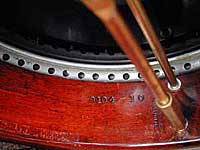
 |
|---|
|
|---|
The serial number is 8104-10. The first number is the lot number, and second is the bin number. Since the rim is stamped "PAT.APPLD FOR", and the Patent application was in September, 1925, it must have been made shortly thereafter.
Gibson usually made a few instruments of the same type at the same time. They all had the same lot number, but occupying different cubbyholes within the "bin." The listing of Gibson serial numbers by Tom Biggs has another of the same lot but bin number 23-- so at least 23 instruments of a similar style were made.
 |
|---|
The tone ring is of the "ball-bearing" type. This configuration consisted of a metal "tone tube" onto which was brazed a smaller diameter steel rod. The banjo head rested on this rod, went over the tube, and was pulled by the stretcher band over an outside support ring. The hollow tube rested upon 24 ball bearings (located at the point of each bracket). These ball bearings were, in turn, resting upon a small washer which was resting on a coiled spring, resting on a washer. This configuration was patented by Gibson employee George Altermatt, and was designed, says the patent, to provide constant tension upon the calfskin head as it loosened and tightened as the weather changed. The patent was applied for on September 28, 1925 and issued on July 24, 1928 as U.S. Patent number 1,678,456.
There were two configurations of these models. The earlier models had holes in the outer support ring, and the tone tube was spaced away from this ring by a scalloped hoop brazed to the outside of the tube. The later models had a plain support ring and the spacer was solid-- contacting the ring all around.
I have heard a few of both types, and I have not heard one of the second variation that sounded OK to my ears-- they were somehow "thin" and quiet.
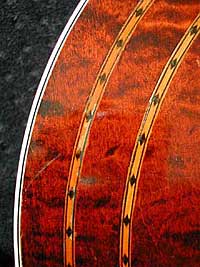 |
|---|
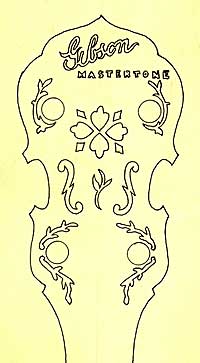 |
|---|
The banjo is made from curly (tiger-striped or fiddle-back) maple, stained to a rich reddish brown. The resonator is bound with a white/black/white plastic on both top and bottom rim. The back is inlaid with two concentric rings of wooden marquetry of a diamond pattern.
The original neck was bound as the resonator-- white/back/white with diamond pattern marquetry. It had an ebony fingerboard inlaid with the hearts and flowers pattern. The peghead had the word "MASTERTONE" written in pearl, just under and to the right of the script "Gibson." The original neck also had an oval wood marquetry inlay on the back of the peghead.
The metal, as in all Granada models, is gold plated. It is simply engraved on the flange and has the typical Granada "scallop" engraving on the stretcher band.
The tone ring is NOT gold plated.
The tailpiece is a Kushner with the word "Granada" engraved, and the tuning pegs had mother of pearl buttons.
I bought the banjo in 1962 from Harry West for $450-- which included a new five-string neck. The neck was made by Robbie Robinson from Ohio. I had asked for the neck to be "Reno" style with the "Flying Eagle" inlay pattern. I gave Robbie the measurements of the neck from Harry's RB-3 which I had been playing and found very comfortable.
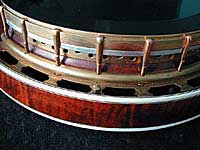 |
|---|
The banjo came without an armrest, so I bought a new one and had it gold-plated. I did not have it engraved to match what the original would have been.
 |
|---|
Robbie had some marquetry similar to that used on the "5" series banjos, and ran a strip up the sides of the neck. The binding on the neck is a single ivoroid strip and not the white/black/white as found on the resonator. The peghead is a bit thinner than Gibson had made, and the ebony overlay is much thicker than the original. These four small details really bothered me, but I've lived with them all these years.
Shortly after getting the banjo, I traded the mother of pearl tuning buttons for old "amber" buttons.
After seeing a scalloped fifth string capo, I took out the HO-gauge railroad spikes I had installed, and made my own capo from sheet brass.
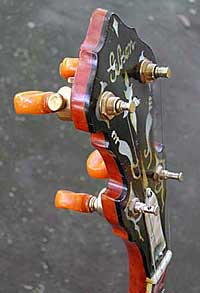 |
|---|
The banjo is fitted with two standard "Keith-Scruggs tuners". They were, I believe, the first gold set made.
I fooled around with a number of bridges, and finally designed and made my own. My thinking was that the ideal bridge weighs nothing and covers the whole head. I made a bridge from solid rock maple, and had wide feet on it, but a thin section. It has been on the banjo for at least 30 years.
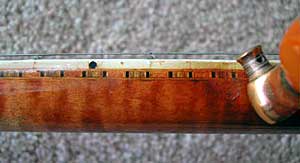 |
|---|
The original calfskin head was replaced when I got the banjo in 1962 with a "Weather King" head. It remained on the banjo until 1991 when I happened to see a banjo with a Deering black mylar head. I thought "Boy! That black would look good against the gold!" I asked around, and my old friend Matty Umanov had one in stock and gave it to me. It seemed to be the same thickness as the old one (I measured them both with a micrometer), so I put it on and tightened it up. It sounded just fine. Took a while getting used to playing a "black hole."
The banjo was re-fretted by John Zeidler in Philadelphia in 1993.
I have a feeling that the fingerboard was flattened a bit after the inlays went in. The inlay on the third fret was very thin. One evening in 1967 when I was living in Roosevelt, NJ, I was playing some music with Mike Seeger at his house. I felt as if I had torn a piece off my nail, so I put my thumb under it and gave it a "flick."
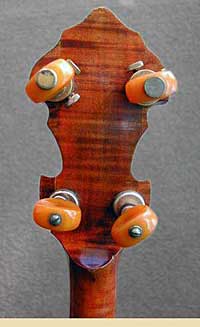 |
|---|
 |
|---|
When I got home I looked at the banjo and noticed a piece of inlay missing. Oops! I went back to Mike's house and scoured the carpet until I found the missing piece.
About six months later I was playing in the back pasture at Sunset Park and I felt as if I broke a piece of nail. Flick. Oops! This time the piece was gone forever in tall grass. I never replaced it. Over the years the rest of the inlay has fallen out.
The banjo is one of the few I have played which does well with both clawhammer style and Scruggs style. The tone is very "cutting" and although it is not loud I've been told it can be heard all the way across the parking lot!
I worked to get the tone I was looking for-- the sharp, cutting sound that I heard on the old Stanley Brothers records. The bridge I made certainly has something to do with it, as does the tightness of the head which is very tight. As Don Reno once said, "tighten it up until it breaks then back off a bit."
Bill Keith once described the tone as "The best example of the worst sounding banjo I've heard." I'm honored!
At the Winterhawk reunion of the NY Ramblers in 1990, someone commented that they never heard a banjo like mine except on old records. They always thought that the hardness and brittleness was part of the old recording process. They never thought that a banjo could REALLY sound like that! Well, mine does-- and I deliberately worked it for that sound.
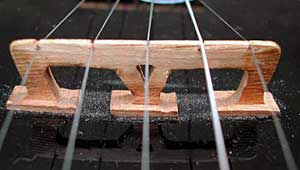 |
|---|
I must also say, that the ultimate tone lays in the right hand of the player. I've heard a few other people play my banjo and it doesn't sound like it does when I play it.
I almost got another banjo only once. I heard there was a 5 string Gibson Bella Voce coming into the Folklore Center in NYC. I already had a commitment from Pete Wernick to buy my banjo if I wanted the other one. I got the call that it was in, and I went down.
I had previously seen only two Bella Voce banjos, and both of them had a natural maple finish, and painted carving. This one was completely painted in a cream-colored finish and had the usual painted carving. The neck was a little narrow for my tastes (it had been made by Mario Martello at Satterlee's in the Bay Area), and I wasn't thrilled with the tone. I was mentally tossing around if I wanted to buy it or not when David Grisman came in. He looked at the banjo and said, "Jesus! What a Puerto Rican banjo! You get that and you're out of the band. No one in the band is going to play something that ugly."
And that was the end of my flirtation with getting another banjo.
|
|---|